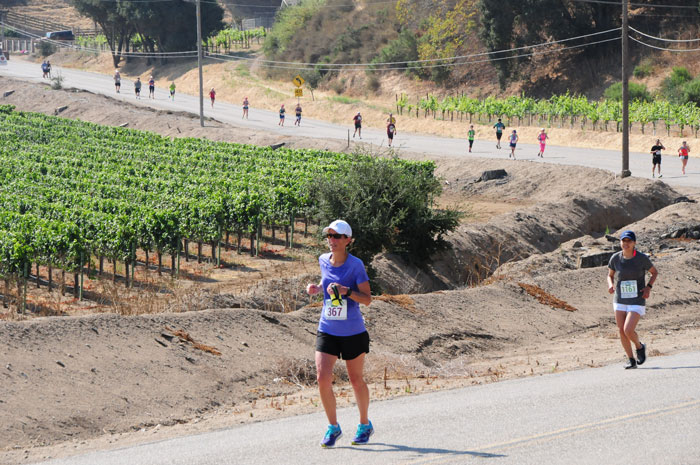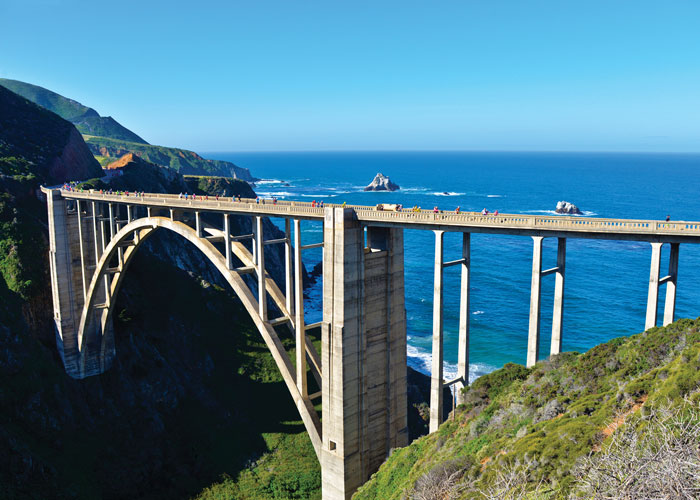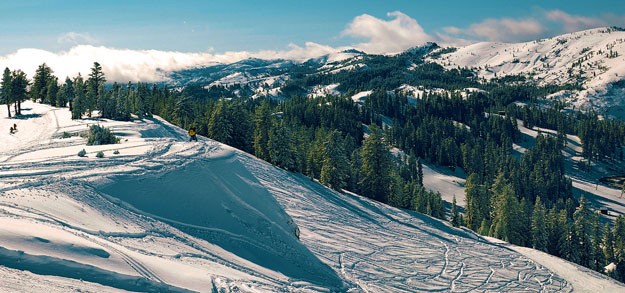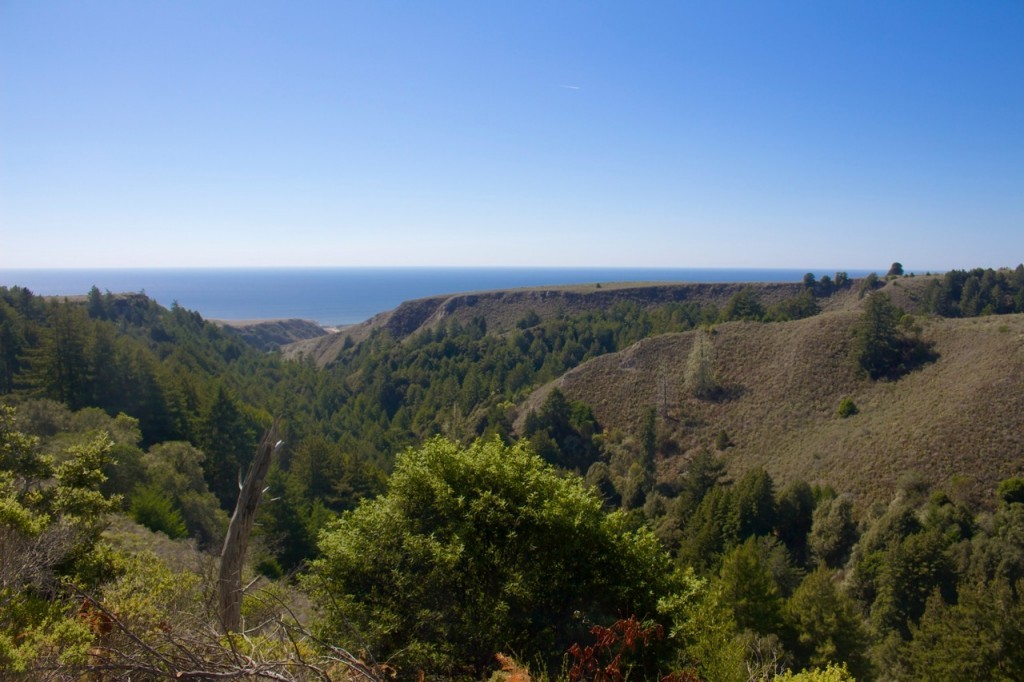- Tahoe’s Nevada Beach Tops the List of Hard-to-Book Campgrounds - 07/17/2024
- Cannabis Watershed Protection Program Cleans Up Illegal Grow Sites - 07/10/2024
- French Fire - 07/05/2024
Running five fourteeners in a day along the Sierra Crest
Words and Photos by Seth Lightcap
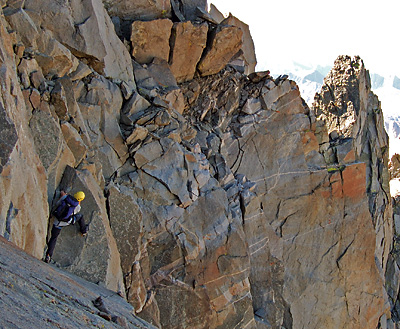 Craning my neck to see off the ledge I scan the terrain above me. I can see a blocky route that could go, but it looks sketchy. We’ve been testing that kind of chunky choss all day … no bueno.
Craning my neck to see off the ledge I scan the terrain above me. I can see a blocky route that could go, but it looks sketchy. We’ve been testing that kind of chunky choss all day … no bueno.
Gotta be here somewhere … I scoot out a little bit farther towards the edge of the ledge.
Bingo! The dihedral corner crack appears. Tucked just out of sight behind the block above me it’s obviously the line. A couple exposed face moves guard the corner’s entrance but my mind has already relaxed: I see feet, I see hands, I see summit.
Anxiety turns to anticipation …
Re-chalk, check feet, test holds, holler a quick, “It goes!” to my partner Pete, and begin to pull down. I lift off the ledge, fancy free onto the easy fifth class. The crown jewel awaits but 60 feet ahead – the 14,242 foot summit of North Palisade, our third 14,000-foot summit of the morning, the high point of our route, but miles from the end of the day’s journey …
Menacing yet mesmerizing, the mighty peaks of the Palisades range are undoubtedly one of the finest escarpments of alpine granite in not only the Sierra Nevada, but in the lower 48. While there are worthy craggy crests in all the western mountain ranges there are few as bold and lofty as the legendary Palisades outside of Big Pine.
Starting from the north with the 13,893-foot summit of Mt. Agassiz, the knife-edge ridge of the Palisades continues south for nine rocky miles before hooking east to the 13,388-foot summit of The Thumb. Along that precipitous crest, the ridge rolls and tumbles over six 14,000-foot summits – Thunderbolt Peak, Starlight Peak, North Palisade, Polmonium Peak, Mt. Sill, and Middle Palisade.
For the mountaineer and climber, these six stoic summits and the traverses between each one are the stuff dreams are made of: You can dance along the rocky crest enchaining peak after pinnacle from sun up to sun down and then some. With few true vertical headwalls and relatively solid ledge systems everywhere, the required up and down climbing is challenging but never ridiculous. Rappels and a stiff boulder problem or two might interrupt forward progress, but tagging the intertwined summits of the Palisades has been an attainable goal since the early days of Sierra adventure.
While all of the Palisades’ fourteeners were summited individually between 1903 and 1931, the first two men to traverse a majority of the treasured summits in one push were John Ohrenschall and John Mathias in 1958. Cruising along the crest for two days, the pair climbed five of the six fourteeners while riding the ridge from Thunderbolt Peak to Mt. Sill.
Since Ohrenschall and Mathias’ visionary adventure, their path has slowly become the “regular” route amongst the many possible traverse variations. Current consensus pegs the ridge between Thunderbolt and Sill as the most elegant section of the Palisades as it can be climbed in a single day and ticks off five of the six highest peaks.
When I first laid eyes on the Palisades in 2000, I was on the top of neighboring Temple Crag. The raw skyline of the Palisades looked terrifyingly long and heinously loose. I envisioned that every inch of the traverse would crumble underneath me the minute I stepped foot upon it. The available guidebooks of the day did little to dissuade my fears. Their route descriptions emphasized the serious length, sustained exposure, and intermittent widow-maker blocks. Summitting the fourteeners was still tempting, but only because they were the big daddies of the range and I yearned for such rarified air. In my five-tennies that summer, the Palisade traverse sounded like a death wish … and an awfully long approach at that.
How wrong I was.
Late last summer, on a glorious September day, my good friend Peter Chapman and I sacked up and bagged the Thunderbolt to Sill traverse. Having heard rumor that it really wasn’t that loose, and armed with a head full of beta thanks to Peter Croft and Kris Haney, we decided that not only were we worthy of the challenge, we were freakin’ amped to slay it. The Palisades were ours for the taking!
The adventure that ensued was every bit as classic and epic as we had dreamed of. Aside from an overzealous false start the day before, our day on the crest went off like lightning – we popped up before dawn, flashed the route, and smoldered back to the car just after sunset … wasted.
Knocking it out camp to car in about 17 hours, the key to our success was speed and confidence. Though we felt the anxious energy that buzzes your brain before any unknown outing, our gung-ho attitude toward the challenge rocketed us out of the gate, while experienced alpine footwork carried us to the finish line in good style.
The crux of the route was the sheer concentration required of such a big push. Other than the summit spire of Thunderbolt Peak, the technical climbing demands are 5.7 and below with only intermittent fifth class sections at that. To run the route safely you just have to make sure you’re paying attention to every block and rock you touch. The ridge is really not that loose, but then again it’s not that solid either.
So what’cha think? You know you wanna summit these sublime fourteeners. If you’re an experienced Sierra mountaineer and you can move fast over five-easy terrain there is really nothing to it but to do it. Well, actually there is 17-odd miles of trail and talus hiking, some loose scrambling, 5.9 bouldering at 14,000 feet, two rappels, and a little something you might call slogging involved. But that’s the fun part right?
To put you in the mood, here’s another few flashbacks from our trip to give you a taste of what’s in store should you undertake the mission:
Leaving the car …
It’s 9 pm and we’re lolly gagging at the South Lake trailhead. The plan is to jump over Bishop Pass via headlamps, bivy just further at Thunderbolt Pass, race up the southwest chute of Thunderbolt pre-dawn, ride the ridge to Sill, then drop west through Glacier cirque and slog back around the west side of the crest back to Bishop Pass then home. A mega day, but do-able. Just gotta get a little sleep …
Bzzzzzz … bzzzzzz … buzzkill. The watch alarm strikes 4 am and I look up from my bag to gray skies above Bishop Pass. We hadn’t made it all the way to Thunderbolt Pass. Pete barely stirs. Crap! It’s cloudy, were behind schedule on distance, and I’m undeniably still exhausted. “Pete … wake up … What do you think?”
Indecision … indecision … decision. We rest all day, move camp to the nearest water below Thunderbolt Pass, and charge the next day. A little hardman-status lost, but undoubtedly a good call. We’re fed and in bed by sunset. When the alarm sounds at 4 am the next day we roar alive, giggling and leaping up the talus of the ascent chute by 4:2O.
Summiting the crux spire of Thunderbolt Peak …
“You’re taller, I bet you can reach those holds easier.”
“I don’t know man. It looks pretty dicey. You’re the rope gun. Jump on up there right quick.”
… and so goes the 6 a.m. conversation as we sit underneath our first summit of the day and the technical crux of our route – the summit spire of Thunderbolt Peak.
Towering maybe 25 feet above the jagged boulders at its base, the pinnacle looks tall and the fall looks gruesome. If it took any protection the 5.9 face would be a one move wonder but there is no way to protect it and the off angle face has few discernible features. Pulling up to the rusty summit bolt will require a spooky mantle on miniscule footholds.
Pete decides he will give it a go. Stoked, I put up my arms to spot him. Within less than a move I’m guiding Pete back to the ground. Just getting on the thing is tricky.
“What did Croft say… Use your buddy?”
Within seconds we understand. I lean my 6’6” ladder-like frame into the rock. Pete balances a killer foothold on my shoulder.
Wham, bam, summit. One down.
Rapping into the U-Notch …
“Check this natty anchor Pete. Let’s use this one.”
We’ve already passed up a couple tattered rap stations complete with flaky, sun-bleached webbing. I grab the red, gold, and green rasta-colored webbing collection and inspect its condition. Looks irie mon. No obvious sun damage and not too dry. Now its time to lace up our rap lines.
In a tricky move to save pack weight, we brought a 30-meter piece of 8.5 mil rope and a 4-meter piece of 2 mil Kevlar tech cord. The plan is to girth hitch the 8.5 mil rope through the anchor and back onto itself with a carabiner, then tie the Kevlar line onto the carabiner. After the rap, we’ll use the Kevlar line to pull the carabiner down the rap line freeing our rope from its temporarily fixed position on the anchor.
The system knots up nicely and soon I’m leaning into the rap line testing to see how badly the carabiner gets cross loaded into the rap ring. Nothing terrible. Unweighting the line we then test the friction of the Kevlar line, pulling the carabiner. Buttery.
I’m off. Pete busts into a chorus of Steel Pulse’s rasta anthem “Red, Gold, and Green” as I drop off the first overhang and outta sight. The rap and subsequent rope retrieval goes smooth and soon were climbing out of the U-Notch on to the blocky ridge leading to our fourth summit – Polmonium Peak.
For More Beta:
For further information about climbing in the Palisades check out Peter Croft’s guidebook, “The Good, The Great, and The Awesome,” RJ Secor’s guidebook, “The High Sierra – Peaks, Passes, and Trails,” or read a bazillion accounts of various climber’s ascents on web forums like summitpost.com or supertopo.com. If you’re keen on making the trek but would like professional assistance, hit up Alpine Skills International, Sierra Mountain Guides, or Sierra Mountain Center. These organizations guide the route each summer over several days.




